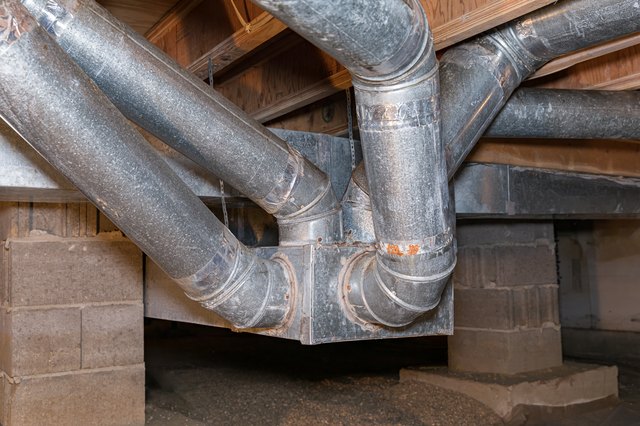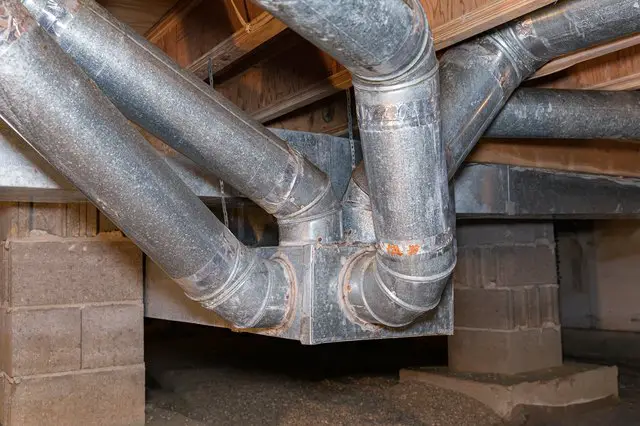Cleaning your furnace flue pipe is an essential part of maintaining your home’s heating system. A clean flue pipe ensures that your furnace operates efficiently, reduces the risk of carbon monoxide buildup, and prolongs the life of your furnace.
However, cleaning a furnace flue pipe can be a daunting task, especially for those who have never done it before. In this article, we will guide you through the process of cleaning your furnace flue pipe, step-by-step, so you can do it yourself and save money on professional cleaning services. So, let’s get started!
- Turn off the furnace and let it cool down completely.
- Locate the flue pipe and remove the cap or cover.
- Use a chimney brush or a wire brush to clean the inside of the flue pipe.
- Use a vacuum cleaner to remove any debris that falls into the furnace.
- Replace the cap or cover and turn the furnace back on.

How to Clean Furnace Flue Pipe: A Step-by-Step Guide
Keeping your furnace flue pipe clean is essential for maintaining the efficiency and safety of your furnace. Over time, soot and debris can build up in the flue, causing blockages that can result in a dangerous buildup of carbon monoxide gas. In this article, we’ll outline a step-by-step guide on how to clean your furnace flue pipe to ensure it’s working efficiently and safely.
Step 1: Preparation
Before you begin cleaning your furnace flue pipe, make sure you have all the necessary tools and equipment. You’ll need a ladder, a flashlight, a wire brush, a vacuum cleaner, a screwdriver, and a bucket. Turn off your furnace and allow it to cool completely before you begin cleaning.
Once you have all your tools, climb up to the roof and locate the furnace flue pipe. Use your flashlight to inspect the pipe for any signs of damage or blockages. If you notice any damage, call a professional to fix it before you proceed with cleaning.
Step 2: Remove the Cap
The next step is to remove the cap from the furnace flue pipe. Use your screwdriver to loosen the screws that hold the cap in place, and then carefully remove the cap. Place the cap in your bucket so you don’t lose it.
Step 3: Clean the Flue Pipe
Now it’s time to clean the flue pipe. Use your wire brush to scrub the inside of the pipe, removing any soot or debris that may have built up. Be careful not to damage the pipe, as this can cause further damage and blockages.
Once you’ve finished scrubbing the inside of the pipe, use your vacuum cleaner to remove any loose debris or soot. Make sure you vacuum the entire length of the pipe to ensure it’s completely clean.
Step 4: Check for Blockages
After you’ve cleaned the flue pipe, it’s important to check for any blockages. Shine your flashlight down the pipe and check for any debris or blockages that may be preventing air from flowing through the pipe. If you notice any blockages, use your wire brush to remove them.
Step 5: Reattach the Cap
Once you’ve finished cleaning and checking the flue pipe, it’s time to reattach the cap. Carefully place the cap back onto the pipe and tighten the screws to hold it in place. Make sure the cap is secure to prevent any debris or animals from entering the pipe.
Step 6: Test Your Furnace
After you’ve cleaned and reattached the cap to your flue pipe, turn on your furnace and test it to ensure it’s working properly. Check the flame to ensure it’s burning blue and steady, and listen for any unusual sounds.
Benefits of Cleaning Your Furnace Flue Pipe
Cleaning your furnace flue pipe is essential for maintaining the efficiency and safety of your furnace. A clean flue pipe ensures that air can flow freely through the pipe, allowing your furnace to work efficiently and reducing the risk of carbon monoxide buildup.
Flue Pipe Cleaning vs. Professional Cleaning
While you can clean your furnace flue pipe on your own, it’s important to note that professional cleaning may be necessary in some cases. If you notice any damage to your flue pipe or if you’re unable to remove blockages on your own, calling a professional is recommended.
Conclusion
Cleaning your furnace flue pipe may seem like a daunting task, but it’s essential for maintaining the efficiency and safety of your furnace. By following these simple steps, you can ensure that your furnace is working properly and reduce the risk of carbon monoxide buildup. Remember, if you’re unsure about anything or notice any damage, don’t hesitate to call a professional for assistance.
Frequently Asked Questions
If you want to ensure the smooth functioning of your furnace and prolong its lifespan, cleaning the furnace flue pipe is an essential task. Here are some common questions and answers to help you with the process.
1. Why is it important to clean the furnace flue pipe?
The furnace flue pipe is responsible for venting out harmful gases and byproducts of combustion from your furnace. Over time, these gases can cause a buildup of debris, soot, and creosote, which can obstruct the flue pipe and prevent it from functioning correctly. A clogged flue pipe can lead to poor furnace efficiency, increased energy bills, and even carbon monoxide poisoning. Therefore, it’s crucial to clean the furnace flue pipe regularly to ensure your safety and avoid costly repairs.
Moreover, cleaning the furnace flue pipe can also help prolong the lifespan of your furnace by preventing damage caused by excessive heat and pressure buildup.
2. When should I clean the furnace flue pipe?
It’s recommended to clean the furnace flue pipe at least once a year or more frequently if you notice any signs of blockage or obstruction. Some common signs include poor furnace performance, unusual noises, and visible soot or debris buildup in or around the flue pipe. If you use your furnace heavily or have pets or children in your home, it’s a good idea to clean the flue pipe more often to ensure optimal performance and safety.
Additionally, it’s crucial to clean the furnace flue pipe before the start of the heating season to ensure that it’s in good condition and free of any blockages or damage that may have occurred during the off-season.
3. How do I clean the furnace flue pipe?
Cleaning the furnace flue pipe is a complex and potentially dangerous task that should only be performed by a professional HVAC technician. The technician will use specialized equipment, such as a chimney sweep, to remove any debris, soot, or creosote buildup from the flue pipe. They will also inspect the pipe for any damage or blockages that may require repairs or replacement.
Attempting to clean the furnace flue pipe yourself can be hazardous and may cause further damage to your furnace or flue pipe. Therefore, it’s always best to leave this task to the experts.
4. How much does it cost to clean the furnace flue pipe?
The cost of cleaning the furnace flue pipe can vary depending on several factors, such as the size of your furnace, the extent of the buildup, and the location of the pipe. On average, you can expect to pay between $100 to $300 for a professional cleaning service. However, the cost may be higher if repairs or replacement are necessary.
It’s always best to get a written estimate from your HVAC technician before scheduling the cleaning service to avoid any surprises or hidden fees.
5. Can I prevent the buildup of debris in the furnace flue pipe?
Yes, there are several things you can do to prevent the buildup of debris in the furnace flue pipe, such as:
– Using high-quality air filters to trap dust and debris before they reach your furnace.
– Regularly inspecting and cleaning your furnace and air ducts to ensure optimal performance and air quality.
– Avoiding burning materials that release excessive amounts of smoke, such as paper or trash.
– Installing a carbon monoxide detector in your home to alert you of any harmful gas buildup.
By following these tips, you can help prevent the buildup of debris in your furnace flue pipe and ensure the optimal performance and safety of your furnace.
How to clean a Furnace flue pipe.
In conclusion, cleaning your furnace flue pipe is an important task that should not be taken lightly. Neglecting this task can lead to serious health hazards and costly damages. By following the steps outlined in this guide and using the right tools, you can ensure that your furnace runs smoothly and safely.
Remember, safety should always come first when cleaning your furnace flue pipe. Be sure to turn off the furnace and disconnect the power before starting any work. Wear protective gear and follow the manufacturer’s instructions carefully.
Regular maintenance and cleaning of your furnace flue pipe will help you save money in the long run by preventing problems before they become major issues. By taking care of your furnace, you are also taking care of your family’s health and safety. Don’t wait until it’s too late – start cleaning your furnace flue pipe today!

